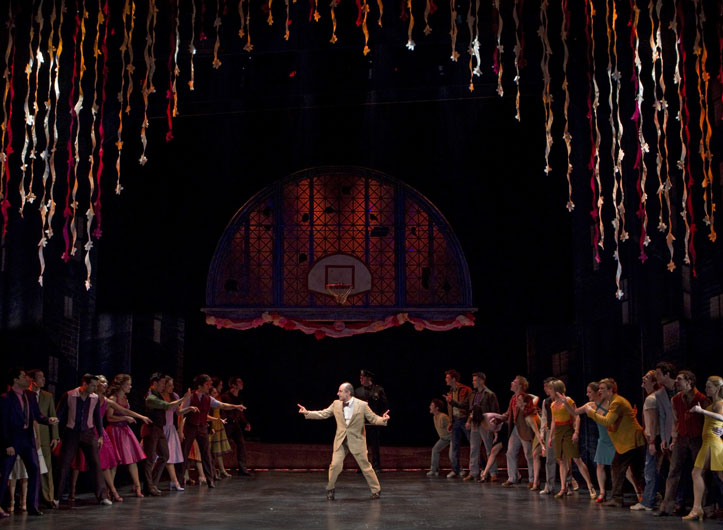STEVEN DEROSA CENTER STAGE IN THE NATIONAL TOUR OF WEST SIDE STORY—FOR ABOUT ONE MINUTE, UNTIL ALL HELL BREAKS LOOSE. THE NATIONAL TOUR OF THE ARTHUR LAURENTS-DIRECTED REVIVAL IS AT THE BUSHNELL IN HARTFORD THROUGH SUNDAY MAY 29.
I’ve been a Stephen DeRosa fan for over 15 years, and rejoice whenever I see his name come up in something cool. I first glommed on to his endearing eyebrow waggles and jittery voice when he was at the Yale School of Drama in the mid-1990s. I must have seen him in over a dozen things: opposite Paul Giamatti in a Yale Cabaret production of Chekhov’s The Bear directed by the then-head of the YSD directing program Earle Gister; as the Troll King in Jean Randich’s expansive production of Peer Gynt. He did a recitation of a then-newly discovered poem thought to be Shakespeare’s (“Shall I Die? Shall I Fly?”) which was tacked on to the beginning of Mark Rucker’s awesome Yale Rep production of Twelfth Night.
“Ahh, Yale! My salad days! A highlight of my quarter century in this business we call show! I did more Cabaret shows than anyone else in my class,” DeRosa recalled with thespianic aplomb in a phone interview a few weeks ago from West Side Story tour stop in Cleveland, Ohio. The tour hit Hartford’s Bushnell on Tuesday for eight performances, ending Sunday May 29.
DeRosa’s classmates at Yale included not just Giamatti but Sanaa Lathan, Suzanne Cryer, Tom McCarthy and Mercedes Herrero, but DeRosa could upstage them all if he felt like it. After graduating, he co-starred in a revival of Charles Ludlams’ The Mystery of Irma Vep with Ludlam’s late partner Everett Quinton. The production went to Broadway and turned the script into a standard that has since been done by regional and community theaters nationwide. DeRosa’s since been a Broadway regular, from the Nathan Lane-starring The Man Who Came to Dinner, the 2002 revival of Into the Woods and Hairspray.
He’s also done dozens of readings of new works, “with more famous people than you can believe, in things nobody ever saw.” One of them was a new musical made out of Gershwin tunes, with a script by Wendy Wasserstein. Another was a Harry Connick Jr. project. It was in a reading that New Haven last got to see Stephen DeRosa, at the Long Wharf Theatre in the Stephen Drukman comedy Going Native. The Long Wharf later did a full Stage II production of the play, but DeRosa was unable to do it.
His career has had a lot of twists and turns, enough that he’s given up on predictions, let alone listing “dream roles.” “You get less attached after a while. You become kind of a fatalist. Like, I really wanted to be Louis in Angels in America on tour. I didn’t get that, but because of dear, wonderful James Bundy”—who was in the Yale School of Drama directing program while DeRosa was in the acting program, and who now is Dean of the whole school—“I got to do a one-act play of Tony Kushner’s instead, creating a role.
“And I never dreamed I’d be playing Eddie Cantor.” Last year DeRosa got to impersonate the whoopee-making Follies superstar in Martin Scorsese’s HBO series Boardwalk Empire, set in Prohibition-era Atlantic City.
“I’ve been blessed to work with people who are really artists—Kushner, Scorsese… geniuses, who are gifted in a spiritual way.” Which brings us to West Side Story. Two of the show’s original creators—lyricist Stephen Sondheim and librettist Arthur Laurents—were deeply involved with this revival. Laurents, who died earlier this month at the age of 93, directed this revival, and was the main motivator behind having some of the Puerto Rican characters’ songs and dialogue done in Spanish.
When DeRosa worked with Sondheim previously for the 2002 Broadway revival of Into the Woods, the role of the Baker was reshaped for the actor. He’s been granted that sort of attention again for West Side Story, even though he wasn’t with the show in New York and joined up for the tour. “There are two or three new lines for Tony,” he says, but his character is the only one that’s been actually enhanced.
“It was the same with Into the Woods—the original creators there to revisit what they’d created. It was not necessarily tailored to [the actors], but changes were made, and I was there to see that happening. Sondheim was still putting changes into Into the Woods three months after we opened.
“That’s the reason why I took the job. I knew Arthur Laurents was creating a new version.” DeRosa was specifically brought into the tour by Associate Director David Saint, who offered him the role and, as DeRosa puts it, “tailored it to my work on the character.”
It’s a bit funny to hear all this fuss being made over that poor shlub Glad Hand.
In weaker hands, he’s one of those roles which could be could be reduced to a mere plot point: as one of very few adults in this saga of teen gangs, he is required to announce and clumsily referee the sexually charged “Dance at the Gym” sequence where Tony (of the Jets gang) and Maria (whose brother and boyfriend are both Sharks) first fall in love. Laurents had high standards, however (his autobiography Original Story By is full of quarrels related to him defending the integrity of his work), and didn’t consider any of the roles he wrote minor. “He told me he wanted the character always to be funny,” DeRosa says. West Side Story’s choreographer/director Harold Robbins —whose original dances are preserved in this production, and are in fact legally required to be maintained in all revivals of the show—worked so intently on his choreography that he had a tendency to overlook issues with the book. When he had a chance to revisit Glad Hand’s character a half century after he first invented it, “Arthur rewrote it,” DeRosa continues. “To get all those testosterone-fueled adolescents at a party.
“Glad Hand is a fool, essentially, and I love fools. His heart is in the right place. He’s all about “Abstinence! Abstinence!” He’s trying to get the kids not be sexual, and of course it doesn’t work. But he’s trying. This is from a time when there weren’t guidance counselors yet in schools.
“It’s this tiny little moment to get us to the dance at the gym—which, of course, becomes one of the most thrilling things you’ll ever experience on the American stage.”
DeRosa really pushes the glories of seeing West Side Story live. “Most people only know the movie. When you hear the score, it’s just fabulous. One thing that’s true—and certainly has been bitched about by Arthur, and echoed by those from the original production—is that, back then, the triple-threat actor/singer/dancer was very rare. Someone like Chita Rivera, or Rita Moreno, who could do it all, was unusual. Nowadays, with the training programs and the American Idol, performance challenges have risen in the American musical theater and the performers are rising to the occasion. It’s exciting for this show to be done again with people who are all acting and singing and dancing at this level.
“It’s a younger cast. Not jaded. They want to do the job. It’s not their fifth tour, or their fifth West Side Story. It’s so thrilling to see it live. I’ve been doing it for seven months, and I’m not tired of it. I’m very grateful. I have have this brief contact with the audience, and just enjoy the benefits of aging.”
Besides playing Glad Hand, DeRosa’s billed as the understudy for the other adult males in the show—Officer Krupke, Detective Shrank and the pharmacist Doc—but he hasn’t yet had to go on in any of those other roles. “These are great old character men, who would probably go on in an iron lung if they had to. There’s no understudy envy, not an Eve Harrington in the wings.”
The current cast of West Side Story tour will be with the show at least through September. The tour itself is booked well into 2012.
“Shakespeare and Sondheim,” Stephen DeRosa confesses giddily, “are probably the reasons I went into theater—to be an idiot, and not got to Georgetown for law. Sondheim is too hard on himself about it, but I think West Side Story is a milestone for the four of them—Laurents, Sondheim, Robbins and Bernstein. Four of the greatest American theater artists, challenging each other to do their best work.”

